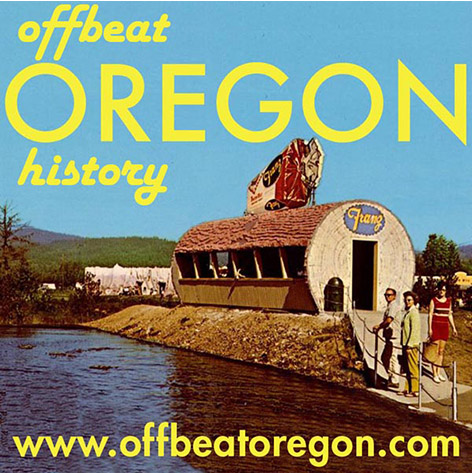OREGON CITY, CLACKAMAS COUNTY; 1890s:
Riverboats on Willamette towed barns, fetched fish
Audio version: Download MP3 or use controls below:
|

The line fit nicely into a little niche between the big freight operations that were then scrapping for the Willamette Valley wheat-shipping business above the falls, and the even-bigger Oregon Railway & Navigation Co., which was at the time battling it out with U.B. Scott for the Columbia River passenger business (more on that rivalry here and here). They specialized in twice-daily runs from Oregon City to Portland. And they’d chosen wisely — there was literally no competition for that run in 1885. The larger operators considered it too small to put a boat on. “We would stop any place for anything,” Alden recalls. “A single passenger or a few bags of farm produce. A cloth ‘flag’ on a stick with a note attached giving the shipper and consignee’s name was sufficient to assure shipment to either Portland or Oregon City. … This resulted in goodwill which carried on through the years and helped us when we did get competition later on.” Sometimes they didn’t even have to stop the boat to take on cargo. “During the salmon run each year … commercial fishermen with boatloads of netted salmon between Portland and Oregon City would hail us, and, as we slowed down, would come alongside and toss their salmon aboard for shipment to Portland,” Alden writes. “These were loose fish, so each shipment had to be separated from others by making cordwood bins, with each bin duly tallied and tagged by the purser as to number of salmon, shipper, and consignee. Our biggest year for loose salmon was 1889, when we carried 16,874.”
They expected a hard fight. But at about the same time, someone discovered hops as a Willamette Valley cash crop, and suddenly there was a huge seasonal demand for transportation of hop pickers to and from the fields. This boom was very timely for the Grahams, who had expected to have to fight for market share with the wheat-freighters.
But around the time of the war, the “Good Roads” initiatives had created a national infrastructure of highways that the riverboats couldn’t beat. Heavy motor trucks were less expensive to run than steamboats, and they could pick up a farmer’s wheat from his actual barn rather than requiring everything to be hauled to the wharf for shipping. By 1918, the Grahams, recognizing the writing on the wall, shut down their operation and sold off their floating stock. “The Grahamona made her last run from Corvallis (to Oregon City) for the O.C.T. Co. in May, 1918,” Alden writes, “and, as I write this in 1941, no other steamboat line has been able to restore the reliable Willamette River service we carried out for the 32 years of our corporate life. I doubt if any ever will. It was the end of the steamboat era.”
|
Background image is an aerial postcard view of Haystack Rock and Cannon Beach, from a postcard printed circa 1950.
Scroll sideways to move the article aside for a better view.
Looking for more?
On our Sortable Master Directory you can search by keywords, locations, or historical timeframes. Hover your mouse over the headlines to read the first few paragraphs (or a summary of the story) in a pop-up box.
... or ...

©2008-2021 by Finn J.D. John. Copyright assertion does not apply to assets that are in the public domain or are used by permission.



